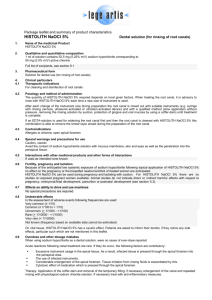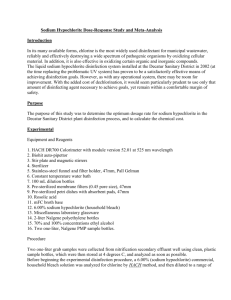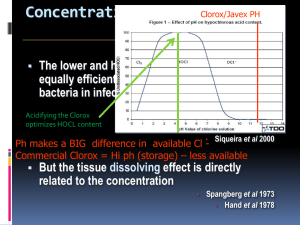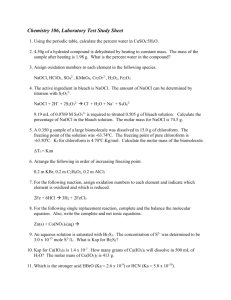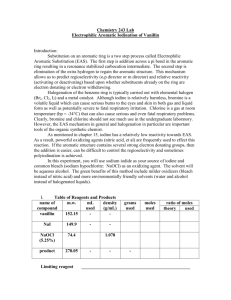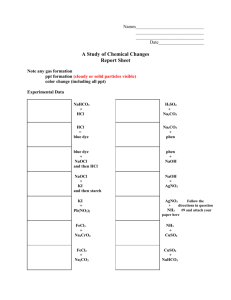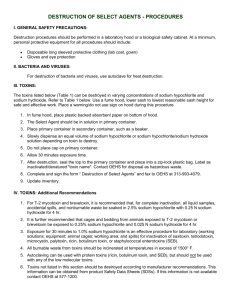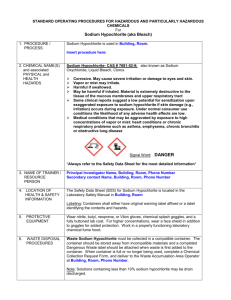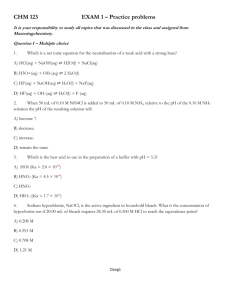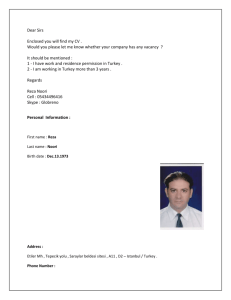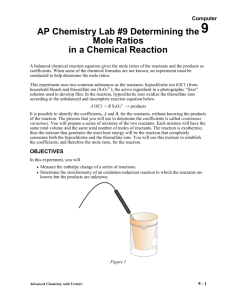NaOCl Accidents - Abstracts
advertisement
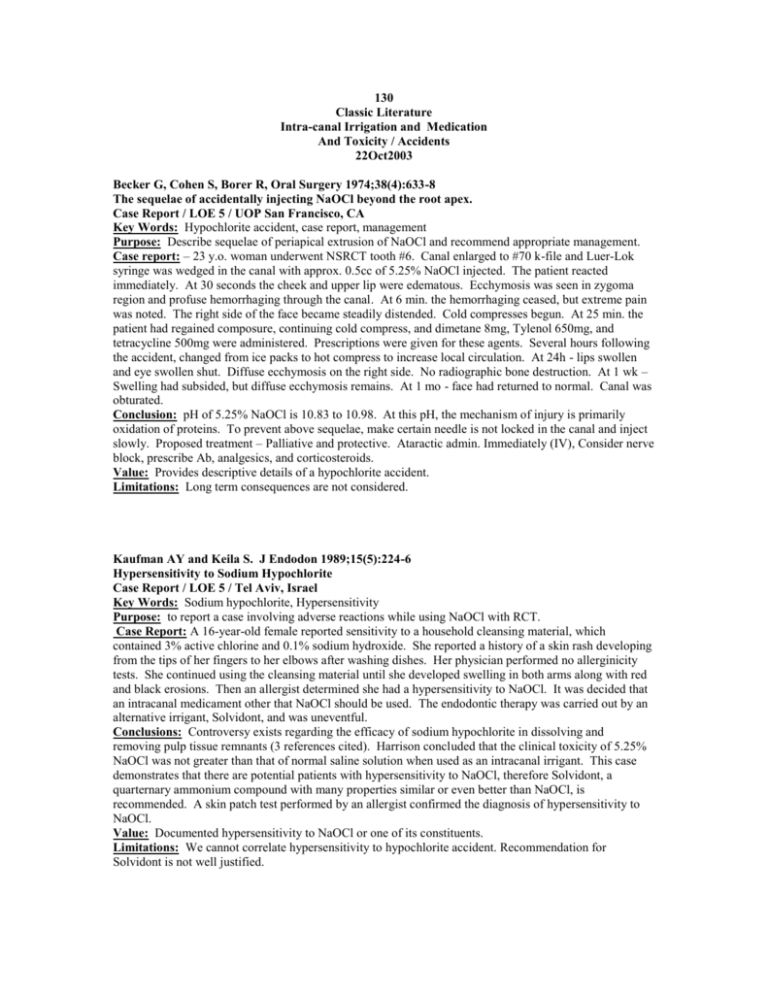
130 Classic Literature Intra-canal Irrigation and Medication And Toxicity / Accidents 22Oct2003 Becker G, Cohen S, Borer R, Oral Surgery 1974;38(4):633-8 The sequelae of accidentally injecting NaOCl beyond the root apex. Case Report / LOE 5 / UOP San Francisco, CA Key Words: Hypochlorite accident, case report, management Purpose: Describe sequelae of periapical extrusion of NaOCl and recommend appropriate management. Case report: – 23 y.o. woman underwent NSRCT tooth #6. Canal enlarged to #70 k-file and Luer-Lok syringe was wedged in the canal with approx. 0.5cc of 5.25% NaOCl injected. The patient reacted immediately. At 30 seconds the cheek and upper lip were edematous. Ecchymosis was seen in zygoma region and profuse hemorrhaging through the canal. At 6 min. the hemorrhaging ceased, but extreme pain was noted. The right side of the face became steadily distended. Cold compresses begun. At 25 min. the patient had regained composure, continuing cold compress, and dimetane 8mg, Tylenol 650mg, and tetracycline 500mg were administered. Prescriptions were given for these agents. Several hours following the accident, changed from ice packs to hot compress to increase local circulation. At 24h - lips swollen and eye swollen shut. Diffuse ecchymosis on the right side. No radiographic bone destruction. At 1 wk – Swelling had subsided, but diffuse ecchymosis remains. At 1 mo - face had returned to normal. Canal was obturated. Conclusion: pH of 5.25% NaOCl is 10.83 to 10.98. At this pH, the mechanism of injury is primarily oxidation of proteins. To prevent above sequelae, make certain needle is not locked in the canal and inject slowly. Proposed treatment – Palliative and protective. Ataractic admin. Immediately (IV), Consider nerve block, prescribe Ab, analgesics, and corticosteroids. Value: Provides descriptive details of a hypochlorite accident. Limitations: Long term consequences are not considered. Kaufman AY and Keila S. J Endodon 1989;15(5):224-6 Hypersensitivity to Sodium Hypochlorite Case Report / LOE 5 / Tel Aviv, Israel Key Words: Sodium hypochlorite, Hypersensitivity Purpose: to report a case involving adverse reactions while using NaOCl with RCT. Case Report: A 16-year-old female reported sensitivity to a household cleansing material, which contained 3% active chlorine and 0.1% sodium hydroxide. She reported a history of a skin rash developing from the tips of her fingers to her elbows after washing dishes. Her physician performed no allerginicity tests. She continued using the cleansing material until she developed swelling in both arms along with red and black erosions. Then an allergist determined she had a hypersensitivity to NaOCl. It was decided that an intracanal medicament other that NaOCl should be used. The endodontic therapy was carried out by an alternative irrigant, Solvidont, and was uneventful. Conclusions: Controversy exists regarding the efficacy of sodium hypochlorite in dissolving and removing pulp tissue remnants (3 references cited). Harrison concluded that the clinical toxicity of 5.25% NaOCl was not greater than that of normal saline solution when used as an intracanal irrigant. This case demonstrates that there are potential patients with hypersensitivity to NaOCl, therefore Solvidont, a quarternary ammonium compound with many properties similar or even better than NaOCl, is recommended. A skin patch test performed by an allergist confirmed the diagnosis of hypersensitivity to NaOCl. Value: Documented hypersensitivity to NaOCl or one of its constituents. Limitations: We cannot correlate hypersensitivity to hypochlorite accident. Recommendation for Solvidont is not well justified. Sabala CL, Powell SE/ JOE 1989(15)10:490-2 Sodium Hypochlorite Injection into Periapical Tissues Case Report/ LOE:5 / Univ. of Oklahoma Key word: Accident, Sodium Hypochlorite, Tissue damage PURPOSE: Demonstrate the extensive amount of tissue changes that can occur when sodium hypochlorite is injected into periapical tissue. TREATMENT: The inadvertent injection of 5.25% sodium hypochlorite into the soft tissue can elicit a violent and frightening response. The sequence seems to be (a) excruciating pain of 2-5 min. duration, (b) immediate swelling (ballooning) of the tissue in the area with spread to surrounding loose connective tissue areas, and (c) a profuse bleeding episode, either interstitially or intraorally through the root canal system. The severe initial pain is replaced with a constant discomfort, probably related to the tissue destruction and distention. The bleeding is readily controlled, but oozing interstitially can result in significant ecchymosis. Treatment should center on alleviation of the swelling, with cold initially and warm saline soaks the following day. Pain control with appropriate analgesic is necessary. Initial control of pain with added local anesthesia must be considered. Infection control should be instituted, as the potential for secondary or spreading of present infection is very real. Reassurance of the patient is very important. The tissue response seems out of proportion to the volume of the irritant. CONCLUSION: The benefits of sodium hypochlorite in endodontic treatment are such that its continued use is justified, but every effort should be taken to avoid the introduction of this irrigant into the periapical tissue. Wedging the irrigating needle into the canal must be avoided. VALUES: Well described and followed, clear treatment guidelines. LIMITATIONS: No evidence to support the ideas. Gatot A, Arbelle J, Leiberman A, Yanai-Inbar L, JOE1991;17(11):573-4 Effects of NaOCl on soft tissues after its inadvertent injection beyond the root apex. Case Report LOE 5, Ben-Gurion Univ. Israel Key Words: Hypochlorite accident, case report, management, histopathology Purpose: Describe sequelae of periapical extrusion of NaOCl and report histopathological findings. Case report: – 32 y.o. woman underwent ReTx tooth #8 with subsequent periapical extrusion of NaOCl with immediate massive edema. ER visit noted swelling extending to the right orbit and severe pain. NaOCl analyzed and pH = 12.9. I.V. hydrocortisone and PenG administered. 36 hours – face steadily distended, epithelial necrosis of upper lip, right eye pain, blurring vision, and right corneal patchy coloration. Then surgical debridement under G.A. with copious saline irrigation and wound left open. I.V. PenG and chloramphenicol. At 2 weeks, the wound healed, but with dimples, scarring, and right infraorbital nerve anesthesia. Histopathological exam – marked cell injury and necrotic squamous epithelium. Yeast and bacterial infiltration noted. Conclusion: This case shows in vivo the adverse effects of sodium hypochlorite in soft tissues. The histopathological exam demonstrated the high cytotoxicity of NaOCl on vital tissue. The NaOCl was probably not buffered like Dakins solution (NaOCl + sodium bicarbonate) which may account for the very high pH value. Value: Demonstrates the extent of complications that are possible with a hypochlorite accident. Limitations: The patients overall health status is not disclosed. Becking AG. Int Endodon J 1991;24:119-25 Complications in the use of sodium hypochlorite Case reports / LOE: 5 / Amsterdam, Netherland Kewords: NaOCl, accident Purpose: To present three cases of sodium hypochlorite acute response following dental treatment. Review: Typical features of accident NaOCl injection are severe pain, rapidly developing edema, hematoma, necrosis, and abscesses. Temporary parasthesia was reported in two of these cases. Local mucosal inflammation and necrosis occurred in all three cases, while 2 cases involved secondary infections. Suggestions for avoiding NaOCl accidents include: 1) Rubber dam 2) Avoid excessive pressure with irrig. 3) Avoid wedging needles If complications result from a NaOCl accident, one should: 1) Inform pt 2) Stop treatment 3) Start adequate analgesia 4) Administer prophylactic antibiotics or therapeutic in the case of a secondary infection. Value: Good reminder to be careful. Antibiotic suggestion Limitation: Case study only. Ehrich DG, Brian DJ, Walker WA. J Endodon 1993;19(4):180-3 Sodium Hypochlorite Accident: Inadvertent Injection into the Maxillary Sinus Case Report/LOE= 5 /Navel Dental Center, San Diego, CA Key Words: Sodium hypochlorite Accident, Hypersensitivity Purpose: to report a case involving inadvertent injection of NaOCl into the maxillary sinus. Case Report: A 22-year-old man underwent RCT #3. During instrumentation, NaOCl was administered to the palatal canal with a 23-gauge hypodermic needle. The patient indicated that he tasted NaOCl, whereupon the oropharynx was irrigated. The rubber dam seal was verified. Further irrigation caused the same response. The calm patient reported some developing congestion and mild burning sensation in the right maxillary sinus. The path of irrigation was confirmed by allowing saline to accumulate in his sinus and throat. The patient was prescribed Entex LA(antihistamine) bid, 500 mg amoxicillin TID for 7 days, and 800 mg Motrin q6h prn pain. The next day, the patient reported mild soreness, congestion of the right sinus, and a brownish material being expressed when blowing his nose. Four days later, a cloudy seroustype fluid was observed in the palatal canal. Calcium hydroxide was placed, and obturation was completed 27 days later. Conclusions: Instrumentation beyond the apical foramen may have resulted in the described communication. Sodium hypochlorite has a pH of 11 to 12 and cause injury primarily by oxidation of proteins. It seems that the minimal contact with the mucosal surface does not produce the same untoward effect as when it is introduced interstitially. Irrigation should be performed slowly with a non-binding, moving needle. Value: Documented NaOCl incident not resulting in a hypersensitive reaction. Limitations: One testimonial.
